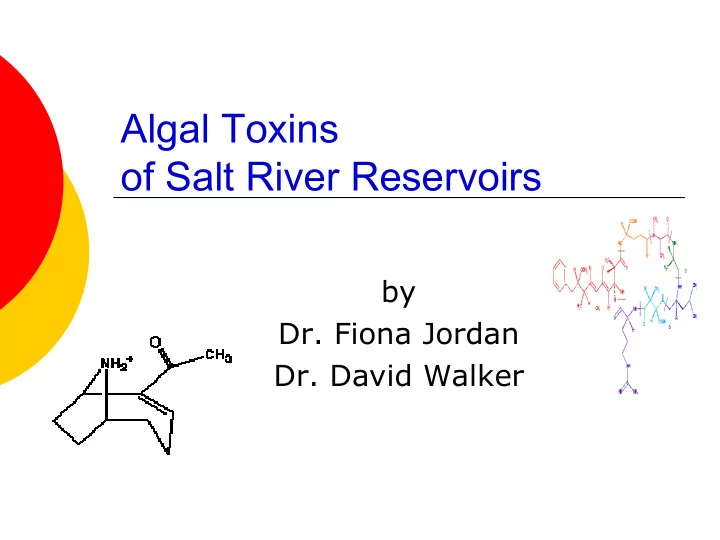

Algal Toxins of Salt River Reservoirs by Dr. Fiona Jordan Dr. David Walker
Background � Fish kills Fish kills � � Algal toxins in fish guts Algal toxins in fish guts � � Neurotoxins Neurotoxins � � Hepatotoxins Hepatotoxins � � Misleading aqueous samples Misleading aqueous samples � � Low Low- -level toxins level toxins � � Short half Short half- -life life � � Low Low- -level algal toxin level algal toxin- -producers producers � � Anabaena & Cylindrospermopsis Anabaena & Cylindrospermopsis � Photo courtesy of Dave Rigo, AzG&F Dept.
Project Goals � Improve toxin detection � Protect public health � Predict & possibly prevent future fish kills.
Aqueous Samples
Known Toxin-Producers Cylindrospermopsis Microcystis Anabaena Anatoxin-a Microcystin-LR Cylindrospermopsin
Genetic Characterization Dendrogram of cyanobacterial 16 S genes (generated by RFLP). Scale bar = similarity coefficients. Numbers 1–4 = clades . Symbols : � neurotoxic ; � non-toxic ; � hepatotoxic ; � toxicity not determined ; � type of toxicity unknown. Lyra et al. (2001)
Lyra et al. (2001) Dendrogram of cyanobacterial genomic fingerprints (generated by REP- and ERIC-PCR). Scale = similarity coefficients. Numbers 1–4 = groups . Symbols : � neurotoxic ; � non-toxic ; � hepatotoxic ; � toxicity not determined ; � type of toxicity unknown.
Toxin Production Environmental triggers ?? Salinity, pH, light, temperature, DOC Single isolate vs mixed culture Characterize toxins HPLC & LCMS –structure and quantity LD 50 ??? • Characterize toxin producers Genes ???
Objectives I. Isolate suspect algal species I. Obtain axenic cultures II. Factors influencing toxin production I. Biotic and abiotic II. Biological assays III. Characterize toxins & isolates
Axenic Cultures • Isolate individual species • Axenic • bacterial-free • uni-algal • Pure cultures • solid or liquid media • Genetic characterization http://honeybee.helsinki.fi/mmkem/MIKRO/PROJEKTI/syano/pullot.jpg
Fish Bioassays � Expose fish to � Individual algae � Environmental conditions = algae � Algal supernatant � Mixed population � Determine lethality/toxicity � Identify toxins � Liquid and tissue � Type and quantity
Recommend
More recommend